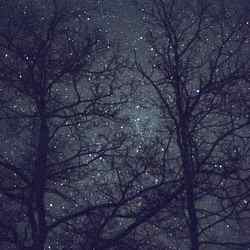
Image credit: Hulett Keaton. Click to enlarge

Image credit: Hulett Keaton. Click to enlarge
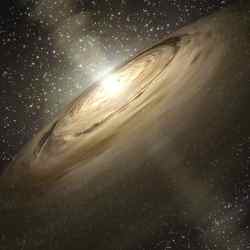
An artist’s impression of the dusty disk orbiting IRS 46. Image credit: NASA/JPL-Caltech Click to enlarge
Astronomers at W. M. Keck Observatory have found ??bf? for the first time ??bf? some of the basic compounds necessary to build organic molecules and one of the bases found in DNA within the inner regions of a planet-forming disk. The object, known as “IRS 46,” is located in the Milky Way galaxy, about 375 light years from Earth, in the constellation Ophiuchus. The results will be published in an upcoming issue of the Astrophysical Journal Letters.
“We see prebiotic organic molecules in comets and the gas giant planets in our own solar system and wonder, where did these chemicals come from?” said Dr. Marc Kassis, support astronomer at the W. M. Keck Observatory. “The Spitzer Space Telescope is letting us study these young stellar objects in new and revealing ways, giving us exciting clues about where life may form in the universe.”
The two organic compounds found — acetylene and hydrogen cyanide — are commonly found in our own solar system, such as the atmospheres of the giant gas planets, the icy surfaces of comets, and the atmosphere of Saturn??bf?s largest moon, Titan. Another carbon-containing species detected, carbon dioxide, is widespread in the atmospheres of Venus, the Earth, and Mars.
“If you add hydrogen cyanide, acetylene and water together in a test tube, and give them an appropriate surface on which to be concentrated and react, you’ll get a slew of organic compounds including amino acids and a DNA purine base called adenine,” said Keck Astronomer Dr. Geoffrey Blake, of the California Institute of Technology in Pasadena and co-author of the paper. “Now, we can detect these same molecules in the planet zone of a star hundreds of light-years away.”
The presence of gas-rich disks around young stars is well known, but little is understood about the chemical structure inside. The discovery of acetylene and hydrogen cyanide in one of these disks will help astronomers better understand these disks, where future solar systems may someday form and possibly result in life.
“Spitzer found something very unique — a young protostar with a dusty disk that, when viewed from Earth, appears tilted on the sky, similar to how some galaxies appear,” Kassis explained. “This viewing angle let the team use Keck-NIRSPEC data to study the inner regions of the disk. The results told the team exactly how the disk was moving and suggest there may be a stellar wind coming from the inner region. Keck also helped measure the high temperatures and the particle concentration in the disk.”
The dust and gas surrounding a young star blocks visible light, but lets longer wavelengths, such as infrared light, pass through. Astronomers can find out what this gas and dust is made of by separating the light into its component wavelengths, or colors.
Since 2003, the NASA Spitzer Space Telescope has allowed astronomers to use this technique to study molecular compounds in protoplanetary disks of young stellar objects. The Spitzer “c2d legacy program” has looked at more than 100 sources in five nearby star-forming regions and only one ??bf? IRS 46 ??bf? showed clear evidence of containing the organic compounds in the warm regions close to the star where terrestrial planets are most likely to form.
“This infant system might look a lot like ours did billions of years ago, before life arose on Earth,” said Fred Lahuis of Leiden Observatory in the Netherlands and the SRON Netherlands Institute for Space Research. Lahuis is the lead author of the paper describing the results.
While the precise events leading up to self-replicating nucleic acids remains unclear, the molecules of acetylene (C2H2) and hydrogen cyanide (HCN) have been shown to produce the base compounds necessary to build RNA and DNA. The team found that the abundance of hydrogen cyanide (HCN) was nearly 10,000 times higher than that found in cold interstellar gas from which stars and planets are born.
Models of early solar-system chemistry have historically centered on data from our own primitive solar system, but now discoveries of protoplanetary disks have opened the field to solar systems other than our own. Theoretical models have suggested that large quantities of complex organic molecules would be present in the inner-most regions of these disks, but until now, no observational tests have been possible.
To help determine where, exactly, the organic-rich gas resides in IRS 46, the team also used submillimeter data from the James Clerk Maxwell Telescope on Mauna Kea. The faint signals observed again suggest that the material originates from the inner disk, perhaps no more 10 astronomical units from the parent star, similar in distance to where Saturn orbits the Sun in our own solar system. However, much additional work remains to be done to know this for certain.
“The gases are very warm, close to or somewhat above the boiling point of water on Earth,” said Dr. Adwin Boogert, also of Caltech. “These high temperatures helped to pinpoint the location of the gases in the disk.”
The Keck-NIRSPEC results point to the presence of a stellar wind emerging from the inner region of the disk orbiting IRS 46. The wind may eventually blow away the dusty debris in the disk, perhaps revealing the presence of rocky, Earth-like planets in several million years.
The Jet Propulsion Laboratory manages the Spitzer Space Telescope mission for NASA’s Science Mission Directorate, Washington. Science operations are conducted at the Spitzer Science Center at Caltech. JPL is a division of Caltech.
The W. M. Keck Observatory is managed by the California Association for Research in Astronomy, a non-profit 501 (c) (3) corporation. The Keck I and Keck II 10-meter telescopes probe the faintest objects in the optical and infrared Universe.
Original Source: W. M. Keck Observatory
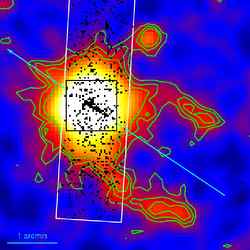
Composite Image of Geminga. Image credit: XMM-Newton Click to enlarge
A team led by Dr. Patrizia Caraveo of the Italian National Institute for Astrophysics (INAF) in Milan discovered this cometary trail with data from NASA’s Chandra X-ray Observatory Archive. The discovery follows the team’s discovery in 2003 using ESA’s XMM-Newton of Geminga’s twin X-ray tails stretching for billions of chilometers.
Together, these observations provide unique insight into the contents and density of the interstellar “ocean” Geminga is plowing through, as well as the physics of Geminga itself. Not only is Geminga close, only about 500 light years from Earth, it is cutting across our line of sight, offering a spectacular view of a pulsar in motion.
“Geminga is the only isolated pulsar we know of showing both a small comet-like trail and a larger tail structure,” said Dr. Andrea De Luca of INAF’s Istituto di Astrofisica Spaziale e Fisica Cosmica, lead author on an article about this discovery in Astronomy and Astrophysics. “This jettison from Geminga’s journey through interstellar space provides unprecedented information about the physics of pulsars.”
A pulsar is a type of rapidly spinning neutron star that emits steady pulses of radiation with each rotation, funnelled along strong magnetic field lines, much like a lighthouse beam sweeping across space. A neutron star is the core remains of an exploded star once at least eight times as massive as the sun.
These dense stars, only about 20 kilometers across, still contain roughly the mass of the sun. Neutron stars contain the densest material known. Like many neutron stars, Geminga got a “kick” from the explosion that created it and has been flying through space like a cannonball ever since.
De Luca said that Geminga’s complex phenomenology of tails and a trail must be from high-energy electrons escaping the pulsar magnetosphere following paths clearly driven by the pulsar??bf?s motion in the interstellar medium.
Most pulsars emit radio waves. Yet Geminga is “radio quiet” and was discovered 30 years ago as a unique “gamma-ray only” source (only later was Geminga seen in the X-ray and optical light wavebands). Geminga generates gamma rays by accelerating electrons and positrons, a type of antimatter, to high speeds as it spins like a dynamo four times per second.
“Astronomers have known that only a fraction of these accelerated particles produce gamma rays, and they have wondered what happens to the remaining ones,” said Caraveo, a co-author on the Astronomy & Astrophysics article. “Thanks to the combined capabilities of Chandra and XMM-Newton, we now know that such particles can escape. Once they reach the shock front, created by the supersonic motion of the star, the particles lose their energy radiating X-rays.”
Meanwhile, an equal number of particles (with a different electric charge) should move in the opposite direction, aiming back at the star. Indeed, when they hit the star’s crust they create tiny hotspots, which have been detected through their varying X-ray emission.
The next generation of high-energy gamma-ray instruments – namely, the planned Italian Space Agency’s AGILE mission and NASA’s GLAST mission – will explore the connection between the X-ray and gamma ray behaviour of pulsars to provide clues to the nature of unknown gamma-ray sources, according to Prof. Giovanni Bignami, a co-author and director of the Centre d’Etude Spatiale des Rayonnements (CESR) in Toulouse, France. Of the 271 higher-energy gamma-ray objects detected by a NASA telescope called EGRET, 170 remained unidentified in other wavebands. These unidentified objects could be “gamma-ray pulsars” like Geminga, whose optical and X-ray light might be visible only because of its nearness to Earth.
Only about a dozen other radio-quiet isolated neutron stars are known, and Geminga is the only one with tails and trails and copious gamma-ray emission. Bignami named Geminga for “Gemini gamma-ray source” in 1973. In his local Milan dialect, the name is a pun on “ghe minga,” which means “it is not there.” Indeed, Geminga was unidentified in other wavelengths until 1993, twenty years after its discovery.
The discovery team also includes Drs. Fabio Mattana and Alberto Pellizzoni of the INAF – Istituto di Astrofisica Spaziale e Fisica Cosmica.
Original Source: INAF News Release
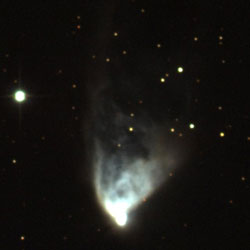
NGC 2262 (Hubble Variable Nebula). Image credit: Hubble. Click to enlarge.
Monday, December 26 – It’s been awhile since we’ve stayed up late, so why not tonight? Tonight let’s use the later rise of the Moon to our advantage and head about 2 degrees northeast of star 13 in Monoceros. Our study will be NGC 2261 – more commonly known as “Hubble’s Variable Nebula.”
Named for Edwin Hubble, this 10th magnitude object is not only very blue in appearance to larger apertures, but is a true enigma. The fueling star, variable R Monoceros, does not display a normal stellar spectrum and may be a protoplanetary system. R is usually lost in the high surface brightness of the “comet-like” structure of the nebula, yet the nebula itself varies with no predictable timetable – perhaps due to dark masses shadowing the star. We do not even know how far away it is, because there is no detectable parallax!
Tuesday, December 27 – Born today in 1571 was Johannes Kepler – Danish astronomer and assistant to Tycho Brahe. Kepler used Brahe’s copious notes of Mars’ positions and formulated the three laws of planetary motion. These laws are still in use today.
So, if you haven’t been studying law… Have you been studying Venus? Right now its super-slim crescent is visible even to binoculars. Rapidly heading towards the Sun, in the next two weeks watch as it disappears, and then reappears in the morning sky by mid-January. Now that’s Kepler’s laws in action!
For a real challenge, try spotting IC 2118 about a thumb’s width west of Beta Orionis before it sets. “The Witch Head Nebula” is a huge area of reflection illuminated by Rigel, but is very faint. With excellent conditions you may be able to spot some patches of nebulosity.
Wednesday, December 28 – If weather provides you with clear skies this evening, let’s work on a study that is within both binocular and telescopic ability. Wait on Orion to rise well, then turn left at Betelgeuse and you will find open cluster NGC 2244 about 2 degrees east of Epsilon Monoceros.
Containing around two dozen resolvable stars, a good, dark night will treat binocular and low power telescope users to NGC 2237 – the “Rosette” nebula. Surrounding this pretty open cluster like a faint, misty wreath, the Rosette may be one of the most massive nebulae known. It is possible that the star cluster may have used all the “raw material” in its formation, leaving the center clear…and it is equally probable that the intense radiation of these hot, young blue stars simply blew away the gas. Either way, this pair will become an annual favorite.
Thursday, December 29 – Heads up to my friends “down under!” On this universal date, the Moon will make a spectacular occultation of Antares for northern Australia. Be sure to check IOTA information well before this event so you’re ready! Wishing you the best of skies…
Today we celebrate the birth of Arthur S. Eddington. Born in 1882, Eddington was a British theoretical astrophysicist who was key in interpreting and explaining the nature of stars. He also coined the astronomical phrase “expanding universe” to refer to the mutual recession of the galaxies.
Tonight let’s have another look at M77, located less than a fingerwidth south of Delta Ceti. This bright, compact, 10th magnitude spiral galaxy can reveal its arm structure to even small telescopes under good conditions. So what’s so special about it? It was one of the first two systems in which a substantial redshift was detected. It’s moving away from us at a speed of 620 miles per second!
Friday, December 30 – It’s New Moon and tonight let’s grab the binoculars and hunt the “Hunter” – Orion. In the northern-most corner of the constellation and just under Taurus, look for a large, kite-shaped collection of stars known as Collinder 65. You’ll find its mixed magnitude stars span almost half the field of view of average binoculars!
Now let’s go for the “head.” The triangular pattern of stars that marks the hunter’s head is home to Collinder 69. The northernmost – Lambda – is the brightest in a cluster of a double handful of stellar gems. Look for a chain of three!
Are you ready for a “belt?” Then check out the three stars that form Orion’s waistline, because as a group these are known as Collinder 70. Not only is the trio a member of the collection, but there are around 100 stars that belong to this expansive open cluster!
Saturday, December 31 – Today is the birthday of Robert G. Aitken. Born in 1864, Aitken was a prolific American observer who discovered and catalogued more than 3100 double and binary stars.
So often double stars are offered up for the telescope, but it seems that very few are suited to binoculars. Tonight will change all that as you have a closer look at the western-most star in Orion’s belt – Mintaka. This beautiful, white, third magnitude star has a white, sixth magnitude companion to its northeast. Separated by almost a half light-year, these twin stars will be a delight, but telescope users might want to have another look. There’s a third, very faint star to the southwest of the primary!
And so, my friends, this brings us to the close of another observing year. What does 2006 have in store? Be sure to stay tuned… Because there is a surprise coming your way! For now, may the New Year bring peace, joy, and prosperity to all of you wonderful readers around the world! May all of us travel at… Light Speed! ? ~Tammy Plotner
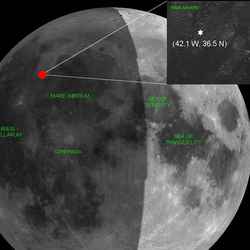
The red dot indicates the location of the recent meteoroid impact. Image credit: NASA/MSFC/Bill Cooke. Click to enlarge
NASA scientists have observed an explosion on the moon. The blast, equal in energy to about 70 kg of TNT, occurred near the edge of Mare Imbrium (the Sea of Rains) on Nov. 7, 2005, when a 12-centimeter-wide meteoroid slammed into the ground traveling 27 km/s.
“What a surprise,” says Marshall Space Flight Center (MSFC) researcher Rob Suggs, who recorded the impact’s flash. He and colleague Wes Swift were testing a new telescope and video camera they assembled to monitor the moon for meteor strikes. On their first night out, “we caught one,” says Suggs.
The object that hit the moon was “probably a Taurid,” says MSFC meteor expert Bill Cooke. In other words, it was part of the same meteor shower that peppered Earth with fireballs in late October and early November 2005. (See “Fireball Sightings” from Science@NASA.)
The moon was peppered, too, but unlike Earth, the moon has no atmosphere to intercept meteoroids and turn them into harmless streaks of light. On the moon, meteoroids hit the ground–and explode.
“The flash we saw,” says Suggs, “was about as bright as a 7th magnitude star.” That’s two and a half times dimmer than the faintest star a person can see with their unaided eye, but it was an easy catch for the group’s 10-inch telescope.
Cooke estimates that the impact gouged a crater in the moon’s surface “about 3 meters wide and 0.4 meters deep.” As moon craters go, that’s small. “Even the Hubble Space Telescope couldn’t see it,” notes Cooke. The moon is 384,400 km away. At that distance, the smallest things Hubble can distinguish are about 60 meters wide.
This isn’t the first time meteoroids have been seen hitting the moon. During the Leonid meteor storms of 1999 and 2001, amateur and professional astronomers witnessed at least half-a-dozen flashes ranging in brightness from 7th to 3rd magnitude. Many of the explosions were photographed simultaneously by widely separated observers.
Since the Leonids of 2001, astronomers have not spent much time hunting for lunar meteors. “It’s gone out of fashion,” says Suggs. But with NASA planning to return to the moon by 2018, he says, it’s time to start watching again.
There are many questions that need answering: “How often do big meteoroids strike the moon? Does this happen only during meteor showers like the Leonids and Taurids? Or can we expect strikes throughout the year from ‘sporadic meteors?'” asks Suggs. Explorers on the moon are going to want to know.
“The chance of an astronaut being directly hit by a big meteoroid is miniscule,” says Cooke. Although, he allows, the odds are not well known “because we haven’t done enough observing to gather the data we need to calculate the odds.” Furthermore, while the danger of a direct hit is almost nil for an individual astronaut, it might add up to something appreciable for an entire lunar outpost.
Of greater concern, believes Suggs, is the spray??bf?”the secondary meteoroids produced by the blast.” No one knows how far the spray reaches and exactly what form it takes.
Also, ground-shaking impacts could kick up moondust, possibly over a wide area. Moondust is electrostatically charged and notoriously clingy. (See “Mesmerized by Moondust” from Science@NASA.) Even a small amount of moondust can be a great nuisance: it gets into spacesuit joints and seals, clings to faceplates, and even makes the air smell when it is tramped indoors by moonwalkers. Could meteoroid impacts be a source of lunar “dust storms?” Another question for the future….
Suggs and his team plan to make more observations. “We’re contemplating a long-term monitoring program active not only during major meteor showers, but also at times in between. We need to develop software to find these flashes automatically,” he continues. “Staring at 4 hours of tape to find a split-second flash can get boring; this is a job for a computer.”
With improvements, their system might catch lots of lunar meteors. Says Suggs, “I’m ready for more surprises.”
Original Source: NASA News Release
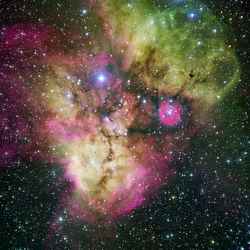
NGC 2467 and Surroundings. Image credit: ESO Click to enlarge
Just like Charles Dickens’ Christmas Carol takes us on a journey into past, present and future in the time of only one Christmas Eve, two of ESO’s telescopes captured various stages in the life of a star in a single image.
ESO’s first image shows the area surrounding the stellar cluster NGC 2467, located in the southern constellation of Puppis (“The Stern”). With an age of a few million years at most, it is a very active stellar nursery, where new stars are born continuously from large clouds of dust and gas.
The image, looking like a colourful cosmic ghost or a gigantic celestial Mandrill, contains the open clusters Haffner 18 (centre) and Haffner 19 (middle right: it is located inside the smaller pink region – the lower eye of the Mandrill), as well as vast areas of ionised gas.
The bright star at the centre of the largest pink region on the bottom of the image is HD 64315, a massive young star that is helping shaping the structure of the whole nebular region.
The first image was taken with the Wide-Field Imager camera at the 2.2m MPG/ESO telescope located at La Silla, in Chile.
Another image of the central part of this area is shown in ESO’s second image. It was obtained with the FORS2 instrument at ESO’s Very Large Telescope on Cerro Paranal, also in Chile.

NGC 2467 and Surroundings. Image credit: ESO Click to enlarge
However, the second image zooms in on the open stellar cluster Haffner 18, perfectly illustrating three different stages of this process of star formation: In the centre of the picture, Haffner 18, a group of mature stars that have already dispersed their birth nebulae, represents the completed product or immediate past of the star formation process. Located at the bottom left of this cluster, a very young star, just come into existence and, still surrounded by its birth cocoon of gas, provides insight into the very present of star birth. Finally, the dust clouds towards the right corner of the image are active stellar nurseries that will produce more new stars in the future.
Haffner 18 contains about 50 stars, among which several short lived, massive ones. The massive star still surrounded by a small, dense shell of hydrogen, has the rather cryptic name of FM3060a. The shell is about 2.5 light-years wide and expands at a speed of 20 km/s. It must have been created some 40,000 years ago. The cluster is between 25,000 and 30,000 light-years away from us.
Original Source: ESO News Release
When I mention to people that I record a regular podcast, I often get some kind of response like, “oh, I can’t listen to that, I don’t have an iPod.” Yikes! Podcasts, despite their name, don’t require an iPod, or even a portable MP3 player of any kind. If you like to listen to radio shows, you’ll love podcasting. I’ve written up an explainer to help you get up to speed, and listen to a whole Universe of free audio content – especially my own podcast. 🙂
Fraser Cain
Publisher
Universe Today
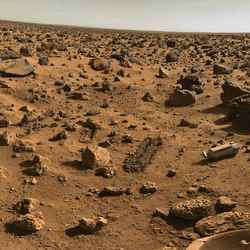
Mars seems not to be as wet as it was predicted. Image credit: NASA Click to enlarge
A region of Mars that some planetary scientists believe was once a shallow lakebed and likely habitable for life may not have been so wet after all, according to a new University of Colorado at Boulder study.
The new study indicates chemical signatures in the bedrock, interpreted in 2004 by the Mars Exploration Rover, or MER, mission team as evidence for widespread, intermittent water at Mars’ surface, may have instead been created by the reaction of sulfur-bearing steam vapors moving up through volcanic ash deposits. Known as Meridiani Planum, the region may have been more geologically similar to volcanic regions in parts of North America, Hawaii or Europe, said Thomas McCollom of CU-Boulder’s Center for Astrobiology.
“Our study indicates it was probably more like parts of Yellowstone, Hawaii or Italy than something like the Great Salt Lake,” said McCollom, also a research associate at CU-Boulder’s Laboratory for Atmospheric and Space Physics. “We think it was far less favorable for past biological activity than other scenarios that have been proposed.”
A paper on the subject by McCollom and CU-Boulder Research Associate Brian Hynek of CU-Boulder’s LASP appears in the Dec. 22 issue of Nature.
A series of scientific papers published in December 2004 by the Mars Exploration Rover team and based on data gathered by the rover Opportunity, concluded that the Meridiani Planum region once probably had a large sea or huge lake that may have waxed and waned over eons. The authors proposed that the evaporation of surface and subsurface water over time left behind various chemical precipitates — predominately sulfate salts — which they interpreted as evidence for a watery environment that would have been conducive for life to exist.
But if the sulfate was the result of precipitation from an evaporating brine of surface and subsurface water as has been proposed, McCollom and Hynek contend the bedrock should be enriched with a large amount of positively charged atoms, known as cations, from minerals like iron, calcium and magnesium. But it is not, they said.
“We think the bedrock was laid down by enormous volcanic ash flows over time that were then permeated by sulfur dioxide-rich steam vapors,” said McCollom. “The sulfur dioxide and water combined to form sulfuric acid, which reacted with and altered the bedrock to give it its present chemical composition.”
The new scenario does not require prolonged interaction between bedrock and a standing body of surface water as proposed by the MER team, and the process likely occurred at high temperatures, perhaps more than 200 degrees F, said McCollom. “Everything about the site seems to be consistent with our conclusions,” he said.
“In our scenario, the water required to support the chemistry in this bedrock would only have had to have been around for months, years or perhaps as much as a few centuries,” said Hynek. “This is very different than previous scenarios, which require that a much larger amount of water be present for many millennia.”‘
The European Space Agency’s Mars Express spacecraft recently showed the chemistry of layered deposits surrounding the Meridiani Planum region is similar to the bedrock at the Opportunity landing site, implying the entire area hosted volcanic activity, said Hynek. The size of the suspected Meridiani Planum volcanic deposits appears much larger than any similar deposit on Earth and encompasses an area roughly the size of Arizona, according to the CU-Boulder researchers.
McCollom described the geology of the region as “solfatara-like,”‘ a term that originated from Solfatara Crater, a volcanic region near Naples, Italy, harboring vents that emit vapors. “While solfataras are riddled with vents and fissures giving off sulfurous vapors at the surface, the deposits we see at Meridiani probably represent the subsurface beneath such fissures,” said McCollom.
On Earth, solfataras host microbes that are capable of using sulfur for sustenance, McCollom said. Some of the areas are now under study by astrobiologists looking to characterize extreme environments on Earth that support life.
“My view is that there is a good possibility there is life on Mars, probably in the subsurface,” he said. “We know from examples on Earth that life can exist in extreme places, and Mars seems to have the necessary ingredients for that.”
Hynek said that in the distant past, Meridiani Planum may have had all the necessary ingredients to support organisms like those found in solfataras. “But the unique and probably short-lived nature of the environment suggests it may not be the best place to look for evidence of Martian life today,” he said.
Original Source: CU-Boulder News Release
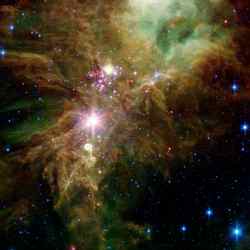
NGC 2264, the Cone Nebula and Christmas Tree Cluster. Image credit: NASA/JPL-Caltech. Click to enlarge
Astronomers using NASA’s Spitzer Space Telescope have given the world a spectacular new picture of a star-forming region called the “Christmas Tree Cluster,” complete with first-ever views of a group of newborn stars still linked to their siblings.
Spitzer’s cameras are very sensitive to the infrared (heat), allowing astronomers to see through the obscuring gas and dust of the star-forming cloud that swaddles infant stars.
The Christmas Tree Cluster, also known as NGC 2264, is a well-studied region in the Monoceros (the Unicorn) constellation. The Christmas Tree Cluster was so named because it looks like a tree in visible light. The nebula is roughly 2,500 light-years away. That is, the nebula emitted the light in the new Spitzer image 2,500 years ago.
For astronomers studying the development of very young stars — stars less than a few million years old — “This region has it all,” said University of Arizona astronomer Erick T. Young.
“We see the dramatic-looking emission of cold gas — clouds that look like thunderheads. We see when the massive molecular cloud breaks up and begins to condense into clumps of stars,” Young said. “And, for the first time, because of Spitzer’s sensitivity, we can see individual stars roughly the size of our sun tightly packed within those clumps.” The cluster of stars is so tightly packed that they must be less than 100,000 years old, he added.
Astronomers are calling this compact collection of bright protostars within the Christmas Tree Cluster the “Snowflake Cluster” because of how they are spaced. The newborn stars are patterned like a single feathery crystal of snow, or geometrically spaced like spokes in a wheel.
The Spitzer observations show that just as theory predicts, the density and temperature of the initial star-forming cloud dictates the spacing between the protostars.
Young is deputy principal investigator for Spitzer’s Multiband Imaging Photometer (MIPS), a UA-built camera that took the longest wavelengths of infrared light used in Christmas Tree Cluster mosaic. Astronomers combined light from MIPS and Spitzer’s Infrared Array Camera (IRAC), developed by the Smithsonian Astrophysical Observatory, in constructing in the picture.
The infant stars appear as pink and red specks in the snowflake cluster that adorns the larger Christmas Tree Cluster in the IRAC and MIPS image. The larger, yellowish spheres are massive stars within the NGC 2264 region. The organic molecules mixed in with dust that surrounds the cluster are illuminated as wisps of green. The blue dots smeared across the image are older Milky Way stars at various distances along the telescope’s line of sight.
NASA’s Jet Propulsion Laboratory, Pasadena, Calif., manages the Spitzer mission for NASA’s Science Mission Directorate. Science operations are conducted at the Spitzer Science Center at the California Institute of Technology in Pasadena. JPL is a division of Caltech.
Original Source: UA News Release
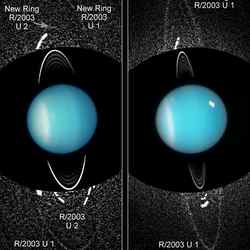
The newly discovered pair of Uranus faint dusty rings. Image credit: NASA Click to enlarge
NASA’s Hubble Space Telescope photographed a new pair of rings around Uranus and two new, small moons orbiting the planet.
The largest ring is twice the diameter of the planet’s previously known rings. The rings are so far from the planet, they are being called Uranus’s “second ring system.” One of the new moons shares its orbit with one of the rings. Analysis of the Hubble data also reveals the orbits of Uranus’s family of inner moons have changed significantly over the past decade.
“The detection of these new interacting rings and moons will help us better understand how planetary systems are formed and sustained, which is of key importance to NASA’s scientific exploration goals,” said Dr. Jennifer Wiseman, program scientist for Hubble at NASA Headquarters.
Since dust orbiting Uranus is expected to be depleted by spiraling away, the planet’s rings must be continually replenished with fresh material. “The new discoveries demonstrate that Uranus has a youthful and dynamic system of rings and moons,” said Mark Showalter of the SETI Institute, Mountainview, California.
Showalter and Jack Lissauer of NASA’s Ames Research Center, Moffet Field, Calif., propose that the outermost ring is replenished by a 12-mile-wide newly discovered moon, named Mab, which they first observed using Hubble in 2003.
Meteoroid impacts continually blast dust off the surface of Mab. The dust then spreads out into a ring around Uranus. Mab’s ring receives a fresh infusion of dust from each impact. Nature keeps the ring supplied with new dust while older dust spirals away or bangs back into the moon.
Showalter and Lissauer have measured numerous changes to the orbits of Uranus’s inner moons since 1994. The moon’s motions were derived from earlier Hubble and Voyager observations. “This appears to be a random or chaotic process, where there is a continual exchange of energy and angular momentum between the moons,” Lissauer said. His calculations predict moons would begin to collide as often as every few million years, which is extraordinarily short compared to the 4.5 billion year age of the Uranian system.
Showalter and Lissauer believe the discovery of the second ring, which orbits closer to the planet than the outer ring, provides further evidence that collisions affect the evolution of the system. This second ring has no visible body to re-supply it with dust. The ring may be a telltale sign of an unseen belt of bodies a few feet to a few miles in size. Showalter proposes that a previous impact to one of Uranus’s moons could have produced the observed debris ring.
Hubble uncovered the rings in August 2004 during a series of 80, four-minute exposures of Uranus. The team later recognized the faint new rings in 24 similar images taken a year earlier. Images from September 2005 reveal the rings even more clearly.
Showalter also found the rings in archival images taken during Voyager 2’s flyby of Uranus in 1986. Uranus’s first nine rings were discovered in 1977 during observations of the planet’s atmosphere. During the Voyager encounters, two other inner rings and 10 moons were discovered. However, no one noticed the outer rings, because they are extremely faint and much farther from the planet than expected. Showalter was able to find them by a careful analysis of nearly 100 Voyager images.
Because the new rings are nearly transparent, they will be easier to see when they tilt edge-on. The new rings will increase in brightness every year as Uranus approaches its equinox, when the sun shines directly over the planet’s equator. When it happens in 2007, all of the rings will be tilted edge-on toward Earth and easier to study. These research data will appear in an upcoming issue of the journal Science.
The Hubble Space Telescope is a project of international cooperation between NASA and the European Space Agency. The Space Telescope Science Institute in Baltimore conducts Hubble science operations. The Institute is operated for NASA by the Association of Universities for Research in Astronomy, Inc., Washington.
Original Source: NASA News Release